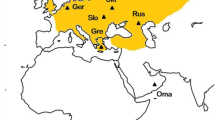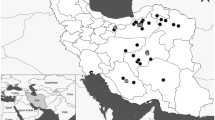Abstract
The diversity of cytochrome b sequences of Carasobarbus species from Iran and adjacent areas was investigated. Two divergent haplotype groups were found for C. luteus. The first one is widespread and congruent with the biogeographical hypothesis of a recent isolation among the various populations as a consequence of rising sea levels following the last Pleistocene glaciation. The second one is restricted to the Khabur River in Syria. The possibility that one of these groups corresponds to C. albus is discussed, but we conclude that it is more likely that C. luteus is a single species that retained two divergent mitochondrial lineages. The mitochondrial sequence diversity found for C. kosswigi and C. sublimus is high, possibly due to small population size and consequent genetic drift. Carasobarbus kosswigi is paraphyletic with respect to C. sublimus, indicating a recent speciation event of these taxa.



Similar content being viewed by others
References
Abdoli A (2000) The inland water fishes of Iran. Iranian Museum of Nature and Wildlife, Tehran
Bianco PG, Bănărescu P (1982) A contribution to the knowledge of the Cyprinidae of Iran (Pisces, Cypriniformes). Cybium 6:75–96
Borkenhagen K (2005) Systematik und Zoogeographie der “großschuppigen Barben” des Vorderen Orients. Christian-Albrechts-Universität, Kiel
Briolay J, Galtier N, Brito RM, Bouvet Y (1998) Molecular phylogeny of Cyprinidae inferred from cytochrome b DNA sequences. Mol Phylogenet Evol 9:100–108
Cantatore P, Roberti M, Pesole G, Ludovico A, Milella F, Gadaleta MN, Saccone C (1994) Evolutionary analysis of cytochrome b sequences in some perciformes: evidence for a slower rate of evolution than in mammals. J Mol Evol 39(6):589–597
Clement M, Posada D, Crandall K (2000) TCS: a computer program to estimate gene genealogies. Mol Ecol 9(10):1657–1660
Coad BW (2005) Endemicity in the freshwater fishes of Iran. Iranian Journal of Animal Biosystematics 1(1):1–13
Coad BW (2010) Barbus. In: Freshwater fishes of Iran. http://www.briancoad.com/Species%20Accounts/Barbus.htm. Accessed 15 Jul 2010
Dasmahapatra KK, Elias M, Hill RI, Hoffman JI (2010) Mitochondrial DNA barcoding detects some species that are real, and some that are not. Molecular Ecology Resources 10(2):264–273
Durand JD, Tsigenopoulos CS, Ünlü E, Berrebi P (2002) Phylogeny and biogeography of the family Cyprinidae in the Middle East inferred from cytochrome b DNA—evolutionary significance of this region. Mol Phylogenet Evol 22:91–100
Esmaeili HR, Teimory A, Hosseini F, Gholami Z (2006) Range extension report for Barbus sublimus Coad and Najafpoor, 1997 (Actinopterygii: Cyprinidae) along with its sympatric species in southwest Iran. Iranian Journal of Animal Biosystematics 2(1):19–24
He D, Chen Y, Chen Y, & Chen Z (2004) Molecular phylogeny of the specialized schizothoracine fishes (Teleostei: Cyprinidae), with their implications for the uplift of the Qinghai-Tibetan Plateau. Chinese Science Bulletin, 49(1):39–48
Heckel JJ (1843) Ichthyologie [von Syrien]. In: von Russegger J (ed) Reisen in Europa, Asien und Africa, mit besonderer Rücksicht auf die naturwissenschaftlichen Verhältnisse der betreffenden Länder unternommen in den Jahren 1835 bis 1841. E. Schweizerbart’sche Verlagshandlung, Stuttgart, pp 990–1099
Krupp F (1985) Systematik und Zoogeographie der Süßwasserfische des levantinischen Grabenbruchsystems und der Ostküste des Mittelmeeres. Johannes Gutenberg Universität, Mainz
Krupp F (1987) Freshwater ichthyogeogreaphy of the levant. Beihefte zum Tübinger Atlas des Vorderen Orients 28:229–237
Machordom A, Doadrio I (2001) Evolutionary history and speciation modes in the cyprinid genus Barbus. P Roy Soc Lond B Bio 268:1297–1306
Nelson JS (2006) Fishes of the world, 4th edn. Wiley, Hoboken
Nylander JAA (2004) MrModeltest v2. Program distributed by the author. Evolutionary Biology Centre, Uppsala University
Rambaut A, Drummond AJ (2007) Tracer v1.4, Available from http://beast.bio.ed.ac.uk/Tracer
Ronquist F, Huelsenbeck JP (2003) MRBAYES 3: Bayesian phylogenetic inference under mixed models. Bioinformatics 19:1572–1574
Šlechtová V, Bohlen J, Perdices A (2008) Molecular phylogeny of the freshwater fish family Cobitidae (Cypriniformes: Teleostei): delimitation of genera, mitochondrial introgression and evolution of sexual dimorphism. Mol Phylogenet Evol 47:812–831
Swofford DL (2003) PAUP*. Phylogenetic analysis using parsimony (*and other methods). Version 4. Sinauer Associates, Sunderland, Massachusetts
Tamura K, Dudley J, Nei M, Kumar S (2007) MEGA4: Molecular Evolutionary Genetics Analysis (MEGA) software version 4.0. Mol Biol Evol 24:1596–1599
Tang Q, Liu H, Mayden R, Xiong B (2006) Comparison of evolutionary rates in the mitochondrial DNA cytochrome b gene and control region and their implications for phylogeny of the cobitoidea (Teleostei: Cypriniformes). Mol Phylogenet Evol 39:347–357
Tsigenopoulos CS, Kasapidis P, Berrebi P (2010) Phylogenetic relationships of hexaploid large-sized barbs (genus Labeobarbus, Cyprinidae) based on mtDNA data. Mol Phylogenet Evol 56:851–856
Wolfart R (1987) Late Cretaceous through Quaternary palaeogeographic evolution of the Middle East. Beihefte zum Tübinger Atlas des Vorderen Orients 28:9–22
Wossughi G (1978) Beitrag zur Systematik und Zoogeographie der Cyprinidae (Pisces, Teleostei) des Mittleren Ostens, unter besonderer Berücksichtigung des Irans. Universität Hamburg, Hamburg
Acknowledgement
We are grateful to J. Freyhof, A. Gholamhosseini, N. Hamidan and H. Zareian for supplying specimens, finclips and tissue samples. We thank Friedhelm Krupp, Masoumeh Malek and Alireza Sari for help with organising KB’s fieldwork in Iran. Friedhelm Krupp offered valuable comments on the manuscript. The study was supported by the Biodiversity and Climate Research Centre (BiK-F), Frankfurt, which is part of research funding programme “LOEWE”. KBs fieldwork was funded by the German Academic Exchange Service (DAAD), in the framework of the project “Establishment of a Middle Eastern Biodiversity Network”. We are also thankful to Shiraz University for financial support.
Author information
Authors and Affiliations
Corresponding author
Rights and permissions
About this article
Cite this article
Borkenhagen, K., Esmaeili, H.R., Mohsenzadeh, S. et al. The molecular systematics of the Carasobarbus species from Iran and adjacent areas, with comments on Carasobarbus albus (Heckel, 1843). Environ Biol Fish 91, 327–335 (2011). https://doi.org/10.1007/s10641-011-9787-1
Received:
Accepted:
Published:
Issue Date:
DOI: https://doi.org/10.1007/s10641-011-9787-1




